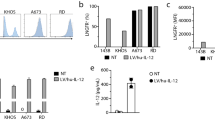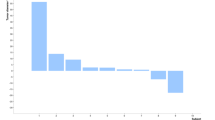Abstract
Interleukin (IL)-23 is a member of the IL-12 family of heterodimeric cytokines, comprised of p19 and p40 subunits, which exhibits immunostimulatory properties similar to IL-12. We have demonstrated previously that adenoviral-mediated, intratumoral delivery of IL-23 (Ad.IL-23) was able to induce systemic antitumor immunity. Here we demonstrate that Ad.IL-23 requires endogenous IL-12 for conferring an antitumor effect after adenoviral-mediated, intratumoral delivery. In contrast, Ad.IL-12 does not require IL-23 for its antitumor effects although endogenous IL-23 appears important for induction of systemic antitumor immunity by IL-12. However, despite the requirement for endogenous IL-12, co-delivery of IL-23 and IL-12 does not provide even an additive local or systemic antitumor effect, regardless of the dose. We further demonstrate that although the use of a single-chain IL-23 (scIL-23) results in higher level of expression and a more pronounced IL-23-mediated antitumor effect, there is still no synergy with IL-12. These results demonstrate that although significant antitumor effects are achieved by intratumoral injection of adenovirus expressing either scIL-23 or IL-12 alone and that IL-23 requires endogenous IL-12 for maximum antitumor benefit, the combined use of these cytokines provides no additive or synergistic effect.
This is a preview of subscription content, access via your institution
Access options
Subscribe to this journal
Receive 12 print issues and online access
$259.00 per year
only $21.58 per issue
Buy this article
- Purchase on Springer Link
- Instant access to full article PDF
Prices may be subject to local taxes which are calculated during checkout





Similar content being viewed by others
References
Perussia B . Tumor infiltrating cells. Lab Invest 1992; 67: 155–157.
Kobayashi M, Fitz L, Ryan M, Hewick RM, Clark SC, Chan S et al. Identification and purification of natural killer cell stimulatory factor (NKSF), a cytokine with multiple biologic effects on human lymphocytes. J Exp Med 1989; 170: 827–845.
Trinchieri G . Interleukin-12: a cytokine at the interface of inflammation and immunity. Adv Immunol 1998; 70: 83–243.
Kubin M, Kamoun M, Trinchieri G . Interleukin 12 synergizes with B7/CD28 interaction in inducing efficient proliferation and cytokine production of human T cells. J Exp Med 1994; 180: 211–222.
Chan SH, Perussia B, Gupta JW, Kobayashi M, Pospisil M, Young HA et al. Induction of interferon gamma production by natural killer cell stimulatory factor: characterization of the responder cells and synergy with other inducers. J Exp Med 1991; 173: 869–879.
Hsieh CS, Macatonia SE, Tripp CS, Wolf SF, O’Garra A, Murphy KM . Development of TH1 CD4+ T cells through IL-12 produced by Listeria-induced macrophages. Science 1993; 260: 547–549.
Ma X, Chow JM, Gri G, Carra G, Gerosa F, Wolf SF et al. The interleukin 12 p40 gene promoter is primed by interferon gamma in monocytic cells. J Exp Med 1996; 183: 147–157.
Trinchieri G . Interleukin-12 and the regulation of innate resistance and adaptive immunity. Nat Rev Immunol 2003; 3: 133–146.
Brunda MJ, Luistro L, Warrier RR, Wright RB, Hubbard BR, Murphy M et al. Antitumor and antimetastatic activity of interleukin 12 against murine tumors. J Exp Med 1993; 178: 1223–1230.
Noguchi Y, Jungbluth A, Richards EC, Old LJ . Effect of interleukin 12 on tumor induction by 3-methylcholanthrene. Proc Natl Acad Sci USA 1996; 93: 11798–11801.
Nanni P, Nicoletti G, De Giovanni C, Landuzzi L, Di Carlo E, Cavallo F et al. Combined allogeneic tumor cell vaccination and systemic interleukin 12 prevents mammary carcinogenesis in HER-2/neu transgenic mice. J Exp Med 2001; 194: 1195–1205.
Colombo MP, Trinchieri G . Interleukin-12 in anti-tumor immunity and immunotherapy. Cytokine Growth Factor Rev 2002; 13: 155–168.
Gambotto A, Tuting T, McVey DL, Kovesdi I, Tahara H, Lotze MT et al. Induction of antitumor immunity by direct intratumoral injection of a recombinant adenovirus vector expressing interleukin-12. Cancer Gene Ther 1999; 6: 45–53.
Oppmann B, Lesley R, Blom B, Timans JC, Xu Y, Hunte B et al. Novel p19 protein engages IL-12p40 to form a cytokine, IL-23, with biological activities similar as well as distinct from IL-12. Immunity 2000; 13: 715–725.
Byrne P, McGuirk P, Todryk S, Mills KH . Depletion of NK cells results in disseminating lethal infection with Bordetella pertussis associated with a reduction of antigen-specific Th1 and enhancement of Th2, but not Tr1 cells. Eur J Immunol 2004; 34: 2579–2588.
Parham C, Chirica M, Timans J, Vaisberg E, Travis M, Cheung J et al. A receptor for the heterodimeric cytokine IL-23 is composed of IL-12Rbeta1 and a novel cytokine receptor subunit, IL-23R. J Immunol 2002; 168: 5699–5708.
Lo CH, Lee SC, Wu PY, Pan WY, Su J, Cheng CW et al. Antitumor and antimetastatic activity of IL-23. J Immunol 2003; 171: 600–607.
Shan B, Yu L, Shimozato O, Li Q, Tagawa M . Expression of interleukin-21 and -23 in human esophageal tumors produced antitumor effects in nude mice. Anticancer Res 2004; 24: 79–82.
Shan BE, Hao JS, Li QX, Tagawa M . Antitumor activity and immune enhancement of murine interleukin-23 expressed in murine colon carcinoma cells. Cell Mol Immunol 2006; 3: 47–52.
Ugai S, Shimozato O, Yu L, Wang YQ, Kawamura K, Yamamoto H et al. Transduction of the IL-21 and IL-23 genes in human pancreatic carcinoma cells produces natural killer cell-dependent and -independent antitumor effects. Cancer Gene Ther 2003; 10: 771–778.
Hu J, Yuan X, Belladonna ML, Ong JM, Wachsmann-Hogiu S, Farkas DL et al. Induction of potent antitumor immunity by intratumoral injection of interleukin 23-transduced dendritic cells. Cancer Res 2006; 66: 8887–8896.
Kaiga T, Sato M, Kaneda H, Iwakura Y, Takayama T, Tahara H . Systemic administration of IL-23 induces potent antitumor immunity primarily mediated through Th1-type response in association with the endogenously expressed IL-12. J Immunol 2007; 178: 7571–7580.
Reay J, Kim SH, Lockhart E, Kolls J, Robbins PD . Adenoviral-mediated, intratumor gene transfer of interleukin 23 induces a therapeutic antitumor response. Cancer Gene Ther 2009; 16: 776–785.
Belladonna ML, Renauld JC, Bianchi R, Vacca C, Fallarino F, Orabona C et al. IL-23 and IL-12 have overlapping, but distinct, effects on murine dendritic cells. J Immunol 2002; 168: 5448–5454.
Happel KI, Zheng M, Young E, Quinton LJ, Lockhart E, Ramsay AJ et al. Cutting edge: roles of Toll-like receptor 4 and IL-23 in IL-17 expression in response to Klebsiella pneumoniae infection. J Immunol 2003; 170: 4432–4436.
Bilbao R, Reay DP, Hughes T, Biermann V, Volpers C, Goldberg L et al. Fetal muscle gene transfer is not enhanced by an RGD capsid modification to high-capacity adenoviral vectors. Gene Ther 2003; 10: 1821–1829.
Oniki S, Nagai H, Horikawa T, Furukawa J, Belladonna ML, Yoshimoto T et al. Interleukin-23 and interleukin-27 exert quite different antitumor and vaccine effects on poorly immunogenic melanoma. Cancer Res 2006; 66: 6395–6404.
Ghilardi N, Kljavin N, Chen Q, Lucas S, Gurney AL, De Sauvage FJ . Compromised humoral and delayed-type hypersensitivity responses in IL-23-deficient mice. J Immunol 2004; 172: 2827–2833.
Hou W, Kang HS, Kim BS . Th17 cells enhance viral persistence and inhibit T cell cytotoxicity in a model of chronic virus infection. J Exp Med 2009; 206: 313–328.
Langowski JL, Zhang X, Wu L, Mattson JD, Chen T, Smith K et al. IL-23 promotes tumour incidence and growth. Nature 2006; 442: 461–465.
Acknowledgements
This work was supported by Grants CA100327 and AR051456 from the National Institutes of Health to P.D.R.
Author information
Authors and Affiliations
Corresponding author
Ethics declarations
Competing interests
The authors declare no conflict of interest.
Rights and permissions
About this article
Cite this article
Reay, J., Gambotto, A. & Robbins, P. The antitumor effects of adenoviral-mediated, intratumoral delivery of interleukin 23 require endogenous IL-12. Cancer Gene Ther 19, 135–143 (2012). https://doi.org/10.1038/cgt.2011.78
Received:
Revised:
Accepted:
Published:
Issue Date:
DOI: https://doi.org/10.1038/cgt.2011.78
Keywords
This article is cited by
-
New insights into IL-12-mediated tumor suppression
Cell Death & Differentiation (2015)



